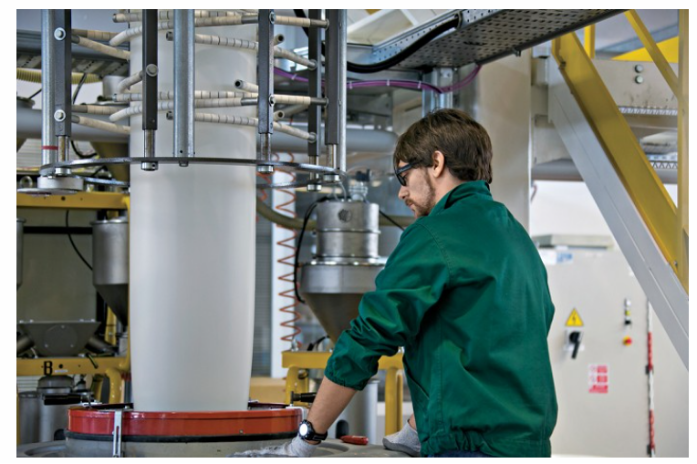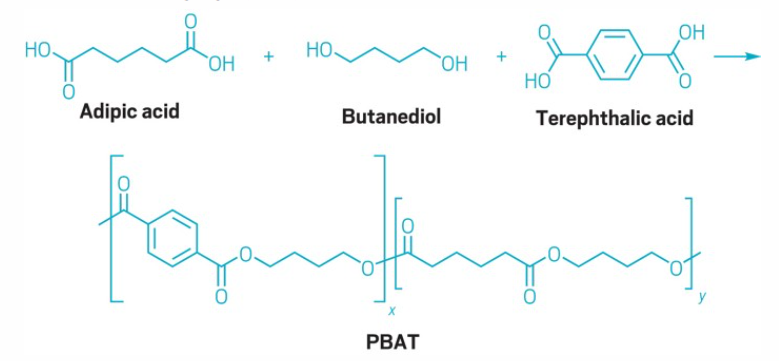The biodegradable polymer PBAT is hitting the big time
2023-05-12 10:55
Polybutylene adipate co-terephthalate is succeeding by straddling the peterochemical and biopolymer worlds

The perfect polymer—one that balances physical properties and environmental performance—doesn’t exist, but polybutylene adipate co-terephthalate (PBAT) comes closer than many.
Producers of synthetic polymers have for decades failed to stop their products from ending up in landfills and oceans, and they are now under pressure to take responsibility. Many are redoubling efforts to boost recycling to fend off critics. Other firms are trying to tackle the waste problem by investing in biodegradable biobased plastics such as polylactic acid (PLA) and polyhydroxyalkanoate (PHA), hoping natural degradation will mitigate at least some of the waste.
But both recycling and biopolymers face obstacles. Despite years of effort, the plastics recycling rate in the US, for instance, is still less than 10%. And biopolymers—often the products of fermentation—struggle to achieve the same performance and manufacturing scale of the established synthetic polymers they are meant to replace.
PBAT combines some of the beneficial attributes of synthetic and biobased polymers. It is derived from common petrochemicals—purified terephthalic acid (PTA), butanediol, and adipic acid—and yet it is biodegradable. As a synthetic polymer, it can readily be produced at large scale, and it has the physical properties needed to make flexible films that rival those from conventional plastics.
Interest in PBAT is taking off. Established producers such as Germany’s BASF and Italy’s Novamont are seeing increased demand after decades of cultivating a market. And they are being joined by over a half-dozen Asian producers, which expect brisk business in the polymer as regional governments push for sustainability.
Marc Verbruggen, former CEO of the PLA maker NatureWorks and now an independent consultant, considers PBAT the “cheapest and easiest way to make a bioplastics product.”He sees it emerging as the preeminent flexible bioplastic, ahead of contenders such as polybutylene succinate (PBS) and PHA. And it will likely become one of the two most important biodegradable plastics overall, alongside PLA, which he says is becoming the major product for rigid applications.
PBAT’s main selling point—its biodegradability—comes from ester linkages, as opposed to carbon-carbon backbones seen in non-degradable polymers such as polyethylene, according to Ramani Narayan, a professor of chemical engineering at Michigan State University. Ester bonds are susceptible to hydrolysis and attack from enzymes.
For example, PLA and PHA are polyesters that degrade when their ester linkages are broken. But the most common polyester—polyethylene terephthalate (PET), used for fiber and soda bottles—doesn’t break down so easily. This is because of the aromatic rings in its backbone, which come from PTA. The rings, which impart structural properties, also make PET hydrophobic, according to Narayan. “Water cannot get in that easily, and it slows down the whole hydrolytic process,” he says.
Some clever chemistry led to the invention of PBAT in the 1990s as a bridge between aliphatic and aromatic polyesters.
BASF produced polybutylene terephthalate (PBT), a polyester made using butanediol, and the firm’s researchers were looking for a biodegradable polymer they could readily produce. They substituted the aliphatic diacid adipic acid for some of the PTA in the PBT. Separating the aromatic sections of the polymer this way made it biodegradable. At the same time, enough PTA was left to give the polymer worthwhile physical properties.
Narayan rates the biodegradability of PBAT a little better than that of PLA, which needs industrial composting to break down. But it doesn’t quite match commercially available PHAs, which are biodegradable in ambient conditions, even in marine environments.
Experts most often compare the physical properties of PBAT to low-density polyethylene, a stretchy polymer used to make films, such as for trash bags.
PBAT is regularly blended with PLA, a polymer with rigid, polystyrene-like properties that lend stiffness. BASF’s Ecovio brand is based on such blends. For example, Verbruggen says, a compostable shopping bag is typically 85% PBAT and 15% PLA.

Polybutylene adipate co-terephthalate (PBAT) is produced by reacting adipic acid, butanediol, and terephthalic acid.
Novamont adds another dimension to formulation. The company blends PBAT, as well as other biodegradable aliphatic-aromatic polyesters, with starches to create resins for specific applications.
“Novamont, for the last 30 years, has always been addressing applications where the degradability adds value to the product itself,” says Stefano Facco, the company’s new business development manager.
One big market for PBAT is mulch films, which are laid around crops to prevent weeds and help retain moisture. When polyethylene films are used, they must be pulled up and often landfilled. But biodegradable films can be tilled right back into the soil.
Another big market is compostable refuse bags, used for food service and household collection of food and yard waste. Bags from companies like BioBag, which Novamont recently acquired, have been available at retailers for years.
“The major ecological benefits of compostable plastics result from their end of life, because these products help to divert food waste from landfills or incineration to organic recycling,” says Joerg Auffermann, BASF’s team leader for global business development in biopolymers.
Over the years, the biodegradable polyester industry has moved into applications beyond films. For example, in 2013, Swiss Coffee Company launched coffee capsules made with BASF’s Ecovio resins.
An emerging market for Novamont’s materials is biodegradable cutlery, which can be composted along with other organic matter. Facco says the cutlery has been taking off in places, such as Europe, that have passed regulations limiting the use of single-use plastics.
Anticipating more environmentally driven growth, new Asian PBAT players are entering the market. In South Korea, LG Chem is building a 50,000 metric ton (t) per year PBAT plant set to open in 2024 as part of a $2.2 billion sustainability-focused investment program in Seosan. SK Geo Centric, formerly known as SK Global Chemical, and Kolon Industries are partnering on a 50,000 t PBAT plant in Seoul. Kolon, a nylon and polyester maker, is providing the production technology, while SK has access to the raw materials.
The PBAT gold rush is biggest in China. The Chinese chemical distributor OKCHEM projects that Chinese PBAT production will rise to about 400,000 t in 2022 from 150,000 t in 2020.
The largest project on the horizon is from the Chinese PTA maker Hengli. Details are unclear, and the company couldn’t be reached for comment. In media and financial disclosures, Hengli has variously said it is planning a 450,000 t plant or a 600,000 t plant for “PBS-type” biodegradable plastics. But when describing the materials needed for the investment, the company names PTA, butanediol, and adipic acid.
Verbruggen sees a number of drivers for the investments. For one thing, biopolymers of all kinds have experienced a run-up in demand recently. Supply is tight, and thus prices for PBAT and PLA are high.
Moreover, Verbruggen says, the Chinese government has been pushing the country to “go big” into bioplastics. Earlier this year, it passed a law banning nonbiodegradable shopping bags, straws, and utensils.
The PBAT market holds appeal for Chinese chemical makers, Verbruggen says. The technology isn’t complex, especially for companies with experience in polyesters.
PLA, in contrast, is more capital intensive. Before the polymer can be made, a company needs to ferment lactic acid from an ample source of sugar. Verbruggen points out that China has a “sugar deficit” and needs to import carbohydrates. “China is not necessarily a favorable place to build a massive amount of capacity,” he says.
The existing PBAT makers have been keeping up with the new Asian players. In 2018, Novamont completed a project to convert a PET plant in Patrica, Italy, to make biodegradable polyesters. The project doubled its biodegradable polyester output to 100,000 t per year.
And in 2016, Novamont opened a plant that uses fermentation technology developed by Genomatica to make butanediol from sugar. The 30,000 t plant is located in Italy and is the only one of its kind in the world.
The new Asian PBAT makers will likely make a limited number of grades of commodity polymer for large-scale applications, according to Facco. “It’s not rocket science,” he says. In contrast, Novamont will maintain its strategy of serving specialized markets. “This is where we have a certain knowledge and a certain benefit to the market,” he says.
BASF is reacting to the Asian PBAT building trend by getting involved in a new Chinese plant. The company licensed its PBAT technology to the Chinese firm Red Avenue New Materials, which plans to build a 60,000 t in Shanghai by 2022. BASF will sell the output from the facility.
“With upcoming new laws and regulations directing the use of bioplastic materials in packaging, mulch film, and bag applications, the positive market development is expected to continue,” Auffermann says. The new plant will allow BASF to “cater the increasing demand from a local source within the region.”
In other words, BASF—which originated PBAT almost a quarter century ago—is keeping up with bustling new business now that the polymer is becoming a mainstream material.
RELATED NEWS
Enhancing Patient Safety with Posey's Integrated Wireless Solution
Healthcare facilities continuously seek technologies that improve patient safety and operational efficiency. The Posey Wireless Nurse Call Adapter provides a critical link, enabling seamless integration between the Posey 2-in-1 Alarm Sitter On Cue PRO and your hospital's existing nurse call system. This creates a complete, closed-loop safety combination that significantly enhances protection for at-risk patients.








